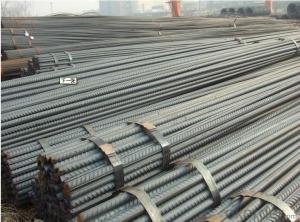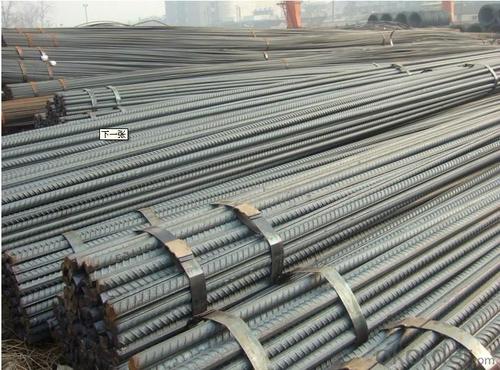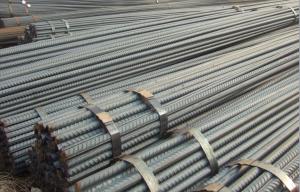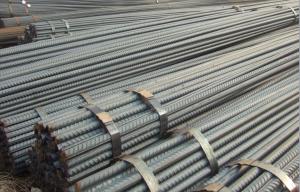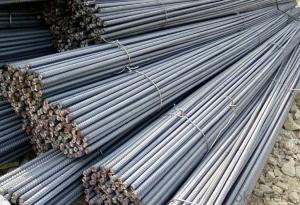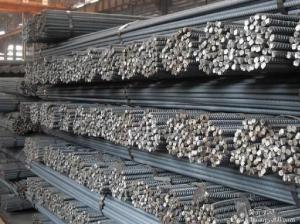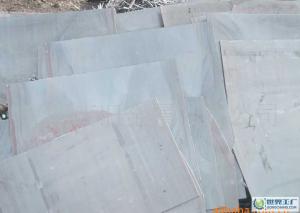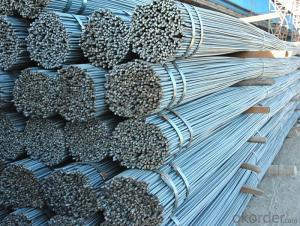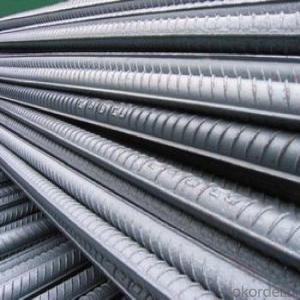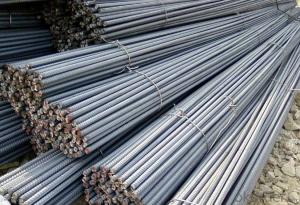High quality deformed bar 6mm-50mm BS4449
- Loading Port:
- Tianjin
- Payment Terms:
- TT OR LC
- Min Order Qty:
- 25 m.t.
- Supply Capability:
- 20000000 m.t./month
OKorder Service Pledge
OKorder Financial Service
You Might Also Like
Product Description:
Product Description:
Specifications of HRB400 Deformed Steel Bar:
Standard | GB | HRB400 | |
Diameter | 6mm,8mm,10mm,12mm,14mm,16mm,18mm,20mm, 22mm,25mm,28mm,32mm,36mm,40mm,50mm | ||
Length | 6M, 9M,12M or as required | ||
Place of origin | Hebei, China mainland | ||
Advantages | exact size, regular package, chemical and mechanical properties are stable. | ||
Type | Hot rolled deformed steel bar | ||
Brand name | DRAGON | ||
Chemical Composition: (Please kindly find our chemistry of our material based on HRB500 as below for your information)
Grade | Technical data of the original chemical composition (%) | ||||||
C | Mn | Si | S | P | V | ||
HRB400 | ≤0.25 | ≤1.60 | ≤0.80 | ≤0.045 | ≤0.045 | 0.04-0.12 | |
Physical capability | |||||||
Yield Strength (N/cm²) | Tensile Strength (N/cm²) | Elongation (%) | |||||
≥400 | ≥570 | ≥14 | |||||
Theoretical weight and section area of each diameter as below for your information:
Diameter(mm) | Section area (mm²) | Mass(kg/m) | Weight of 12m bar(kg) |
6 | 28.27 | 0.222 | 2.664 |
8 | 50.27 | 0.395 | 4.74 |
10 | 78.54 | 0.617 | 7.404 |
12 | 113.1 | 0.888 | 10.656 |
14 | 153.9 | 1.21 | 14.52 |
16 | 201.1 | 1.58 | 18.96 |
18 | 254.5 | 2.00 | 24 |
20 | 314.2 | 2.47 | 29.64 |
22 | 380.1 | 2.98 | 35.76 |
25 | 490.9 | 3.85 | 46.2 |
28 | 615.8 | 4.83 | 57.96 |
32 | 804.2 | 6.31 | 75.72 |
36 | 1018 | 7.99 | 98.88 |
40 | 1257 | 9.87 | 118.44 |
50 | 1964 | 15.42 | 185.04 |
Usage and Applications of HRB400 Deformed Steel Bar:
Deformed bar is widely used in buildings, bridges, roads and other engineering construction. Big to highways, railways, bridges, culverts, tunnels, public facilities such as flood control, dam, small to housing construction, beam, column, wall and the foundation of the plate, deformed bar is an integral structure material. With the development of world economy and the vigorous development of infrastructure construction, real estate, the demand for deformed bar will be larger and larger..
Packaging & Delivery of HRB400 Deformed Steel Bar:
Packaging Detail: products are packed in bundle and then shipped by container or bulk vessel, deformed bar is usually naked strapping delivery, when storing, please pay attention to moisture proof. The performance of rust will produce adverse effect.
Each bundle weight: 2-3MT, or as required
Payment term: TT or L/C
Delivery Detail: within 45 days after received advanced payment or LC.
Label: to be specified by customer, generally, each bundle has 1-2 labels
Trade terms: FOB, CFR, CIF
- Q: How do steel rebars improve the ductility of concrete?
- Steel rebars improve the ductility of concrete by acting as reinforcement within the material. The presence of rebars helps to distribute stress and load more evenly throughout the concrete structure, making it more resistant to cracks and fractures. This reinforcement also allows the concrete to withstand bending and stretching forces, enhancing its overall flexibility and ability to deform without failing.
- Q: What are the guidelines for the proper installation of steel rebars?
- The proper installation of steel rebars is crucial for ensuring the structural integrity and durability of reinforced concrete structures. Here are some guidelines to follow for their proper installation: 1. Planning and Design: Before beginning the installation, it is important to have a detailed plan and design in place. This includes determining the required rebar size, spacing, and configuration based on the structural requirements and specifications. Consulting structural engineers and adhering to local building codes and regulations is essential. 2. Cutting and Bending: Rebars should be cut and bent accurately according to the design specifications. Proper tools such as rebar cutters and benders should be used to ensure clean cuts and precise bends. Any damaged or corroded rebars should be discarded and replaced. 3. Cleaning and Preparation: The surface of the rebars must be free from any contaminants like rust, oil, dirt, or loose scales before installation. Cleaning the rebars using wire brushes or air blasting is recommended to ensure proper adhesion between the rebar and concrete. 4. Placement and Positioning: The rebars should be placed and positioned accurately as per the design drawings. They should be securely tied or supported using tie wires or rebar chairs to maintain the desired spacing and alignment. Splices should be made in accordance with the design requirements and properly lapped to ensure continuity and strength. 5. Concrete Cover: The rebars should be adequately covered with concrete to protect them from corrosion and provide fire resistance. The concrete cover thickness should meet the design specifications and local building codes. Proper spacing between rebars and formwork should be maintained to allow proper concrete flow and consolidation. 6. Anchorage and Embedment: Adequate anchorage and embedment of rebars are essential for transferring loads and ensuring structural stability. Special care should be taken to provide proper hooks, bends, or mechanical anchorage at the ends of rebars as per the design requirements. The rebars should be properly embedded into the adjacent concrete elements to achieve the desired bond strength. 7. Inspection and Quality Control: Regular inspection should be carried out during the installation process to ensure compliance with the design specifications and quality standards. Any deviations or defects should be identified and rectified promptly. It is important to document the installation process and maintain proper records for future reference. By following these guidelines, the proper installation of steel rebars can be achieved, ensuring the structural strength, longevity, and safety of reinforced concrete structures.
- Q: What is the average lifespan of steel rebars in a concrete structure?
- The average lifespan of steel rebars in a concrete structure can vary depending on various factors such as the quality of the rebar, environmental conditions, maintenance, and the design of the structure. However, with proper design, construction, and regular maintenance, steel rebars in a concrete structure can typically last for several decades or even longer.
- Q: What are the guidelines for the proper spacing of steel rebars in slabs?
- The guidelines for proper spacing of steel rebars in slabs typically vary depending on the specific design and structural requirements. However, some general guidelines recommend a minimum spacing of rebars to be at least three times the diameter of the longitudinal bars. Additionally, transverse reinforcement should be placed at regular intervals, typically between 12 to 18 inches, to ensure adequate reinforcement throughout the slab. It is crucial to consult with a structural engineer or refer to local building codes and standards to determine the specific spacing requirements for a given project.
- Q: How are steel rebars measured and labeled?
- Steel rebars are measured and labeled based on their diameter, length, and grade. The diameter is typically measured in millimeters, and rebars can range from 6mm to 50mm in diameter. The length is usually measured in meters or feet, and rebars come in standard lengths such as 6m, 9m, or 12m. The grade refers to the strength and quality of the rebar and is labeled using a number system, such as Grade 40 or Grade 60. Additionally, rebars may also be labeled with relevant certification or marking to ensure compliance with industry standards.
- Q: Are steel rebars easy to handle and install on-site?
- Yes, steel rebars are generally easy to handle and install on-site. They are lightweight, durable, and come in various lengths and sizes, making them convenient to work with. Additionally, their ribbed surface provides better adhesion with concrete, ensuring a secure installation.
- Q: How do steel rebars contribute to the overall safety of a structure?
- Steel rebars contribute to the overall safety of a structure in several ways. Firstly, they provide reinforcement to concrete, which is a brittle material and prone to cracking under tension. By embedding steel rebars within the concrete, the structure gains enhanced tensile strength, allowing it to withstand greater loads and resist cracking or failure. Secondly, steel rebars help to distribute and dissipate stress throughout the structure. When a load is applied to a structure, such as an earthquake or heavy winds, it creates internal forces that need to be managed and dispersed. Steel rebars act as a network of interconnected bars, transferring the load from one rebar to another, and eventually to the foundation. This helps to prevent localized stress concentrations and ensures that the structure can better withstand external forces. Moreover, steel rebars improve the ductility of a structure. Ductility refers to a material's ability to deform without breaking. When a structure is subjected to extreme forces, such as seismic activity or high winds, it needs to be able to flex and absorb energy without collapsing. Steel rebars provide this ductility by elongating and deforming under stress, absorbing and dissipating energy before reaching a critical point of failure. This characteristic makes steel rebars crucial in protecting the overall integrity of the structure and ensuring the safety of its occupants. Furthermore, steel rebars also contribute to the long-term durability of a structure. Concrete is susceptible to various environmental factors, such as moisture, temperature fluctuations, and chemical exposure, which can lead to deterioration and weakening over time. By reinforcing the concrete with steel rebars, the structure becomes more resistant to these factors and maintains its strength and stability for a longer period. In conclusion, steel rebars play a vital role in ensuring the overall safety of a structure. They enhance the tensile strength of concrete, distribute stress, improve ductility, and increase the durability of the structure. By providing these essential properties, steel rebars greatly reduce the risk of structural failure and protect the lives and well-being of those within the building.
- Q: What is the difference between steel rebars and FRP rebars?
- Construction projects use steel rebars and FRP rebars as reinforcement materials, but they differ in composition and mechanical properties. Steel rebars, made of carbon steel, are known for their strength and durability, making them a reliable choice for reinforcing concrete structures. On the other hand, FRP rebars are composed of fibers embedded in a polymer matrix, such as glass or carbon. This composite material offers advantages over steel rebars. Firstly, FRP rebars are lighter, making them easier to handle and transport, reducing labor and equipment costs. Secondly, FRP rebars do not corrode, unlike steel rebars. Steel rebars are prone to corrosion when exposed to moisture and chemicals, weakening the structure over time. FRP rebars, however, are resistant to rust and corrosion, making them ideal for environments with high humidity, saltwater, or chemical exposure. Additionally, FRP rebars have a high resistance to electromagnetic fields, making them suitable for sensitive areas like hospitals, power plants, or telecommunication facilities, where minimizing electromagnetic interference is crucial. However, FRP rebars have lower tensile strength compared to steel rebars, making them less suitable for heavy-load-bearing structures. Moreover, FRP rebars initially cost more than steel rebars, but their long-term durability and reduced maintenance requirements can offset this expense. In conclusion, the differences between steel rebars and FRP rebars lie in their composition, mechanical properties, and performance in various environmental conditions. Steel rebars offer high tensile strength but are susceptible to corrosion, while FRP rebars are lighter, non-corrosive, and have a high resistance to electromagnetic fields. The choice between the two depends on project requirements, load-bearing needs, and environmental factors.
- Q: How are steel rebars affected by chemical exposure?
- Steel rebars are generally resistant to chemical exposure due to their high corrosion resistance. However, certain aggressive chemicals, such as acids or chlorides, can corrode steel rebars over time. This corrosion can weaken the rebars, compromising the structural integrity of the reinforced concrete. Therefore, it is important to protect steel rebars from prolonged exposure to corrosive chemicals to ensure their long-term durability.
- Q: Can steel rebars be used in combination with other reinforcement materials?
- Combining steel rebars with other reinforcement materials is a common practice in construction projects. Steel rebars provide tensile strength and improve overall structural integrity in reinforced concrete structures. However, additional reinforcement materials may be needed in certain cases to meet design requirements or overcome unique construction challenges. For example, in areas with high seismic activity, it is important to prioritize flexibility and ductility. In these situations, steel rebars can be combined with materials like fiber-reinforced polymer (FRP) bars or carbon fiber-reinforced polymer (CFRP) strips. These materials offer increased strength and flexibility, enhancing the structure's ability to withstand seismic forces. Furthermore, when corrosion is a concern, steel rebars can be used alongside corrosion-resistant materials such as stainless steel rebars or epoxy-coated rebars. These materials form a protective barrier, preventing direct contact between the steel rebars and moisture or corrosive agents. Moreover, in specialized applications like precast concrete elements or composite structures, steel rebars can be used in conjunction with other reinforcement materials like prestressed tendons or structural fibers. This combination allows for load redistribution and ensures optimal structural performance. In conclusion, combining steel rebars with other reinforcement materials is an effective way to meet specific construction requirements, improve structural performance, and address challenges related to seismic activity, corrosion, or specialized applications.
Send your message to us
High quality deformed bar 6mm-50mm BS4449
- Loading Port:
- Tianjin
- Payment Terms:
- TT OR LC
- Min Order Qty:
- 25 m.t.
- Supply Capability:
- 20000000 m.t./month
OKorder Service Pledge
OKorder Financial Service
Similar products
Hot products
Hot Searches
Related keywords
